

Tanya Avrith – ReBrand Digital Citizenship. ImageCodr.org. How to attribute a Creative Commons photo from Flickr. Yes, the absolute correct way!

I previously asked how you credit a CC photo from Flickr. Since then I’ve been doing my research and here is the results – The correct way to credit a photo. You need to follow the guidelines set by the license. I’m only going to address attribution. According to Creative Commons you need to: keep intact any copyright notices for the Workcredit the author, licensor and/or other parties (such as a wiki or journal) in the manner they specify;include the title of the Workthe URL for the work if applicableIf you are making a derivative word or adaptation, in addition to the above, you need to identify that your work is a derivative work i.e., “This is a Finnish translation of the [original work] by [author].” or “Screenplay based on [original work] by [author].”
My addition/suggestion Let the author know. That is a lot to include. Example 1. The monkeys are here! Originally uploaded by Librarian by Day blog this test Example 2. Example 3. Example 4. Nine Elements. Nine Themes of Digital Citizenship Digital citizenship can be defined as the norms of appropriate, responsible behavior with regard to technology use. 1.
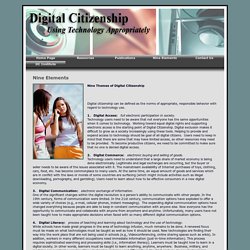
Digital Access: full electronic participation in society. Definition Of Digital Citzenship. The Definition Of Digital Citizenship by Terry Heick As more and more students interact digitally–with content, one another, and various communities–the concept of digital citizenship becomes increasingly important.

Which begs the question: what is digital citizenship? Well, first citizenship, which is formally defined as “the quality of an individual’s response to membership in a community.” This makes citizenship far more complex than a simple legal matter, but rather one that consists of self-knowledge, interaction, and intimate knowledge of a place, its people, and its cultural history. Where Educators Learn About Digital Media. Home. Teacher's Guide to Digital Citizenship. The horror stories of young people not grasping the reach and influence of the content they put online are familiar to all of us.
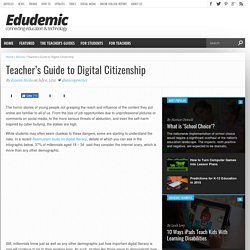
From the loss of job opportunities due to unprofessional pictures or comments on social media, to the more serious threats of abduction, and even the self-harm inspired by cyber bullying, the stakes are high. While students may often seem clueless to these dangers, some are starting to understand the risks. In a recent Rasmussen study on digital literacy, details of which you can see in the infographic below, 37% of millennials aged 18 – 34 said they consider the internet scary, which is more than any other demographic.
Digital Literacy and Citizenship Curriculum – Know your web – Good to Know – Google. At Google we believe in the power of education and the promise of technology to improve the lives of students and educators -- leading the way for a new generation of learning in the classroom and beyond.
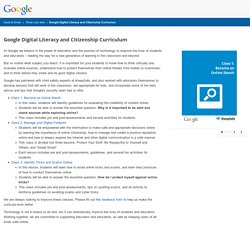
But no matter what subject you teach, it is important for your students to know how to think critically and evaluate online sources, understand how to protect themselves from online threats from bullies to scammers, and to think before they share and be good digital citizens. Google has partnered with child safety experts at iKeepSafe, and also worked with educators themselves to develop lessons that will work in the classroom, are appropriate for kids, and incorporate some of the best advice and tips that Google's security team has to offer.
Class 1: Become an Online Sleuth In this class, students will identify guidelines for evaluating the credibility of content online. Course: Digital Citizenship. Digital Citzenship by Julie Harris of the Rochester Community Schools, Rochester, MI is licensed under a Creative Commons Attribution-NonCommercial-ShareAlike 3.0 Unported License.
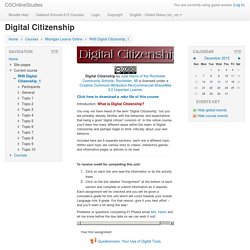
Click here to download a .mbz file of this course Introduction: What is Digital Citizenship? You may not have heard of the term “Digital Citizenship,” but you are probably already familiar with the behaviors and expectations that being a good “digital citizen” consists of. In this online course, you’ll learn the many different areas within the realm of Digital Citizenship and perhaps begin to think critically about your own behavior. Included here are 9 separate sections: each one a different topic. 5 Reasons You Should Be Teaching Digital Citizenship. 5 Reasons You Should Be Teaching Digital Citizenship by Paul Barnwell, Teacher of English & Digital Media Students buzzed about the latest uproar on Instagram.
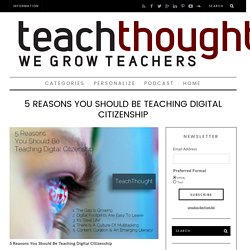
Anonymous sources had posted a “questionable”–and NSFW–list for multiple public schools in our city on Instagram, leading to distraught girls, viral Twitter reactions, and an investigation. 5 Ways You Should Integrate Digital Citizenship Into Your Classes. Recently, I was told by a teacher that she doesn’t have time to teach digital citizenship because she has to cover too many other content-specific standards.

I get it... the Common Core-state tests-AP/IB/SAT/ACT madness eats up so much of our time. Still, there is no excuse for allowing students to enter into the digital world without a toolkit for not only safety but also success. What Your Students Really Need to Know About Digital Citizenship.
In my classroom, I use two essential approaches in the digital citizenship curriculum that I teach: proactive knowledge and experiential knowledge. Proactive Knowledge I want my students to know the “9 Key Ps” of digital citizenship. While I go into these Ps in detail in my book Reinventing Writing, here are the basics: 1. Passwords: Do students know how to create a secure password? 2. 3. 4. 5. 6. 7. 8. 9. Experiential Knowledge During the year, I touch on each of the points above with lessons and class discussions, but just talking is not enough. Truth or fiction: To protect us from disease, we are inoculated with dead viruses and germs. Turn students into teachers: You can have students create tutorials or presentations exposing common scams and how people can protect themselves.
Collaborative learning communities: For the most powerful learning experiences, students should participate in collaborative learning (like the experiences shared in Flattening Classrooms, Engaging Minds). Course: Digital Citizenship Unit.